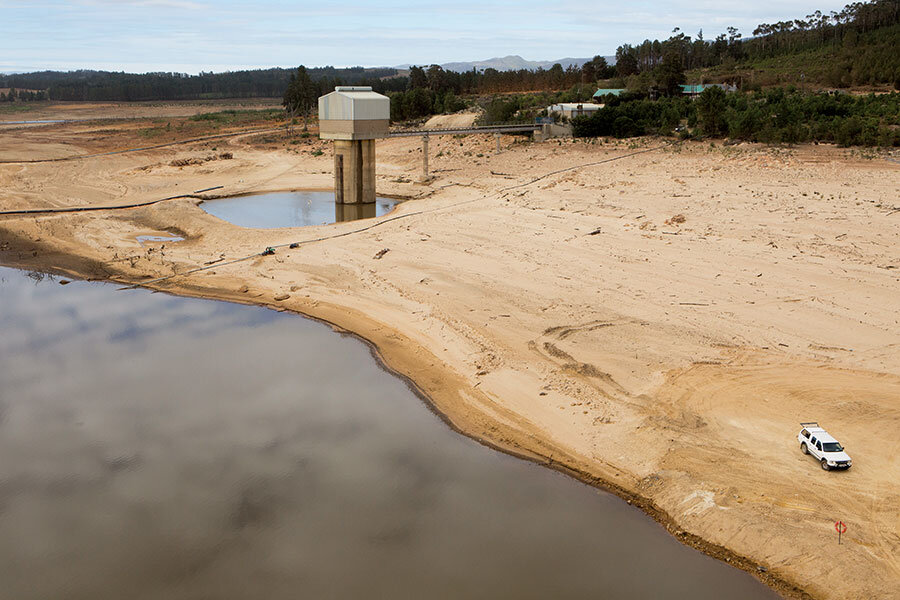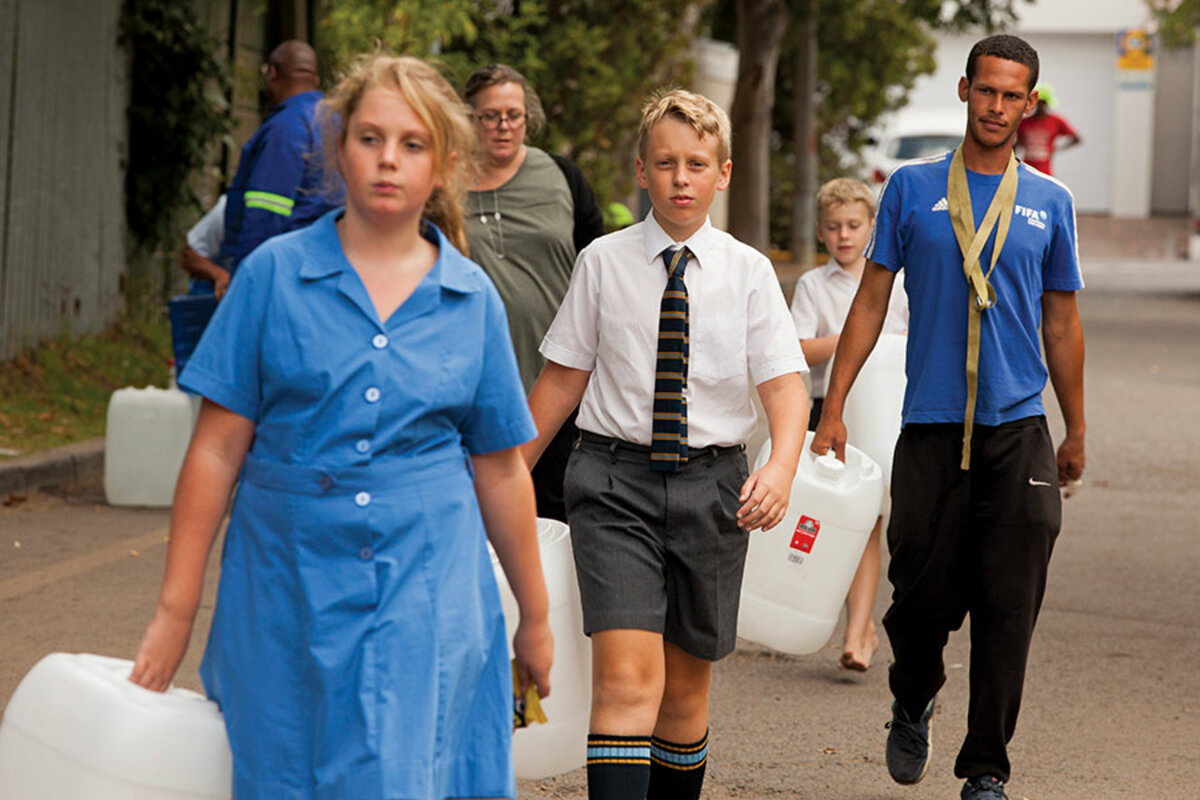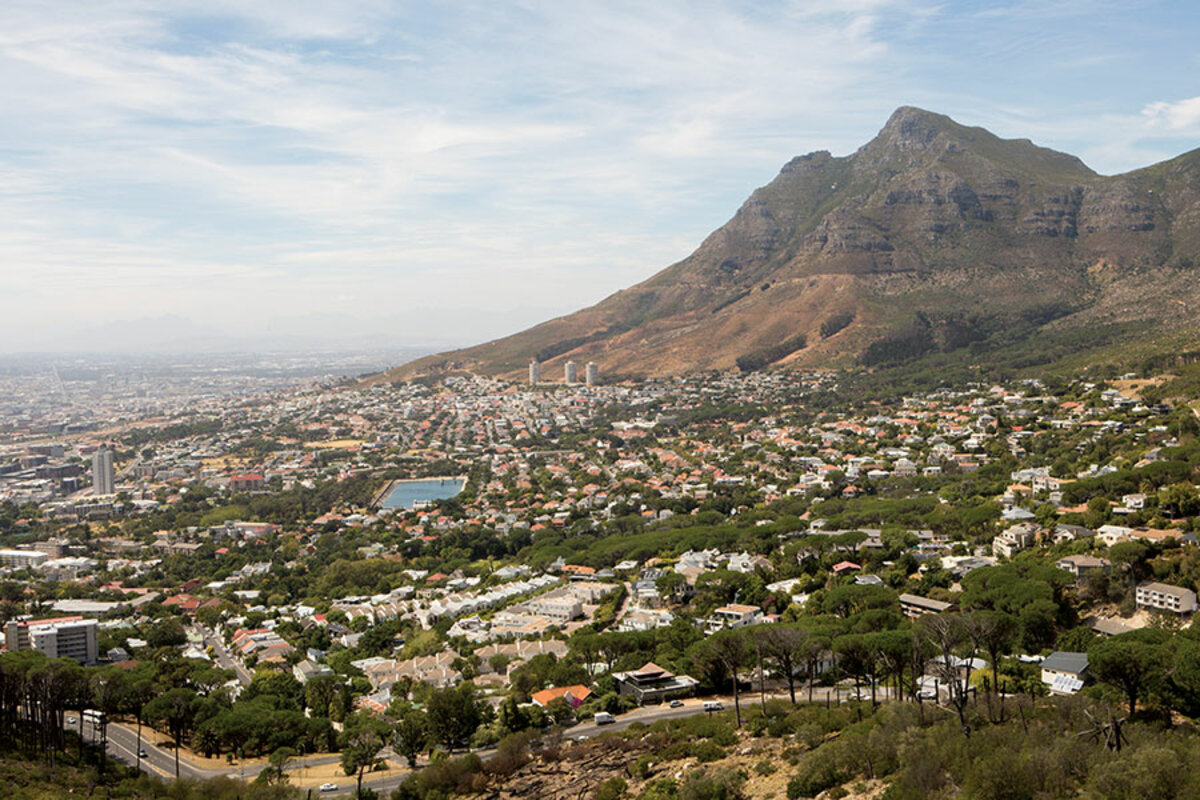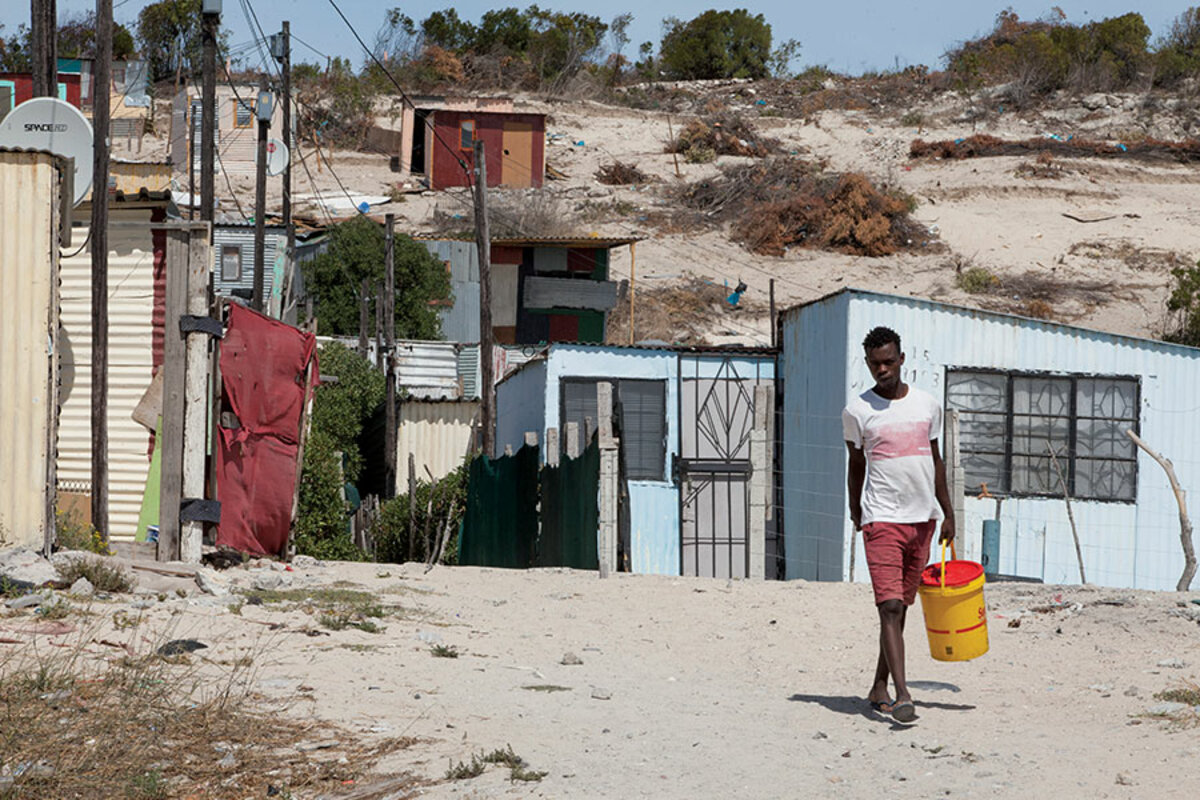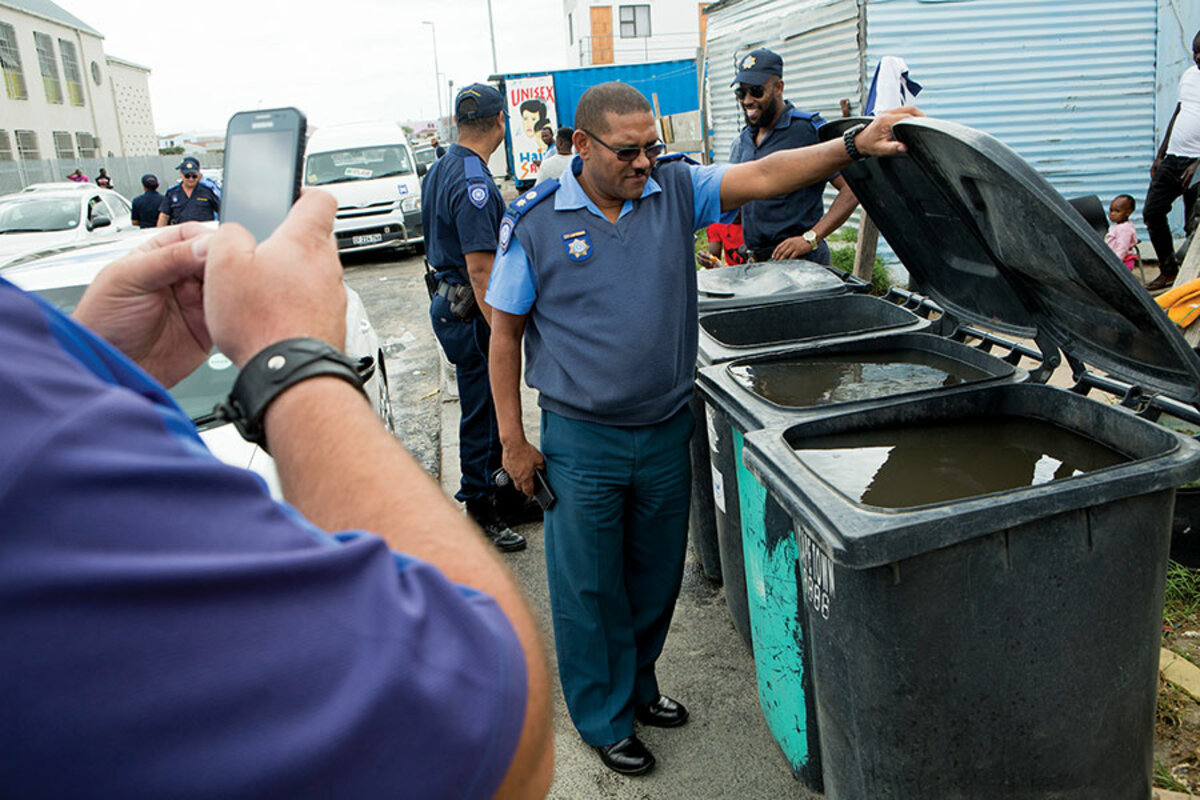Squeezing more out of taps: How Cape Town cut consumption in half
Loading...
| CAPE TOWN, SOUTH AFRICA
Each morning, on opposite sides of this city, two women wake up thinking about water.
For both Helen Moffett and Musa Baba, entire days are choreographed around the vital resource: Where they will get it. How long the line will be. If it will be safe. How little they can manage with and still get by.
Each morning Ms. Baba, a barista, picks her way down a sandy hillside crowded with tin shacks to the communal tap she shares with about 100 of her neighbors. When it’s her turn, she fills a seven-gallon bucket, hoists it onto the top of her head, and carefully walks home, trying not to let too much slosh out into the powdery dust below. That water, after all, has a long day ahead of it. She’ll use it first to wash herself and her kids, then chuck the same water back into a bucket to scrub her floors. Finally, she’ll squeeze out the dregs from the mop, saving them to flush the toilet.
Twenty miles away, Ms. Moffett spends hours each day assembling and maintaining what she calls her “water buffet.” There’s the yellowish water she collects from a spring trickling out beneath a local construction site, jugs of well water she’s bummed from a neighbor, and the trash cans full of rainwater she keeps stashed in her backyard. Bottles and buckets stand at attention around her house, the liquid inside such a wide variety of colors that a friend once quipped that Moffett, a writer, should call her next book “50 Shades of Grey Water.”
A year ago, Baba and Moffett had almost nothing in common, and in many ways, they still live in two different universes. Moffett lives in a manicured gated community flanked by mountains. Baba’s house is two tin rooms she built herself that grip the side of a hill cluttered with other small shacks.
But these days, the two women, along with millions of others here, share a common preoccupation: how to save water. For Baba and many others, that’s been a lifelong project of necessity. But for another population of Cape Town residents, including Moffett, it’s part of a massive lifestyle pivot that has helped bring the city on the southwestern tip of South Africa back from the brink of the unthinkable.
As recently as March, Cape Town’s government was instructing residents to prepare for an imminent “Day Zero,” when taps across most of the city would be shut off indefinitely.
Following three of the driest years in the city’s recorded history, the growing water crisis earned Cape Town a dubious distinction: South Africa’s tourist hub, newspaper headlines across the world blared, was about to become the first developed city in the world to completely run out of water.
But behind the scenes, a tectonic shift was under way. As the city bartered for water with local farmers and hustled to build desalination plants, its residents simply started using less water. A lot less.
And it has worked – at least for now. In March, the city government announced that if current water use patterns held and winter rains fell normally (still a big if), there would be no Day Zero this year.
That’s because since 2016, using a combination of sticks and carrots to coax residents on board, the city has cut its water use by half. Its biggest customers now use 80 percent less. Today, every Capetonian is allowed just 13 gallons of municipal water per day – a little less than the amount it takes to flush a toilet four times. Use more, and the city reduces your pressure to a trickle, and your water bill can turn into a mortgage payment.
By comparison, during its infamous Millennium Drought of 1997 to 2009, Melbourne, Australia, also cut its water consumption by half, but it took 12 years, and at the end of it, residents were still guzzling 17 gallons a day. And between 2012 and 2016, parched California brought its home water use down 25 percent, to about 100 gallons per person per day.
Here in Cape Town, suburban residents have become connoisseurs of taking 90-second showers and then flushing their toilets with the water they collected while doing it. On popular water-saving Facebook groups, city residents debate the best way to wash their dog “off the grid” (bottled water, one woman suggests. Scrub him down with used bath water, offers another.) They swap the names of local companies that will sink a personal well in your backyard. Local police, meanwhile, receive a steady stream of tips from concerned residents who’ve seen their neighbors committing the ultimate middle-class drought crime: watering their lawns.
“There has become a real sense of urgency, even competition [among Capetonians] to see how low you can go [in using water],” says Kirsty Carden, an engineer at the University of Cape Town’s Urban Water Management Research Unit. “Yes, it’s been a crisis, but it’s also good to learn these lessons now. Cape Town isn’t the only city in the world that’s going to need them for the future.”
***
In South Africa – by some measures the most unequal country on earth – water restrictions have had another, less obvious effect: They have given the rich a small but rare experience of how the poor have always gotten by.
“It’s humbling, learning to think about water the way most South Africans have been doing for a long time,” Moffett says, arranging two gallon jugs of water from another local spring in the trunk of her car. “Every household chore takes three times as much thought, and three times as long.”
Plus, she says, “I can’t believe we’ve set up a system in which we pee into drinking water. What a waste!”
“We have always lived like this – nothing has changed because of the drought,” says Baba, sloshing a T-shirt in a sudsy bucket outside her house. “If now rich people can understand better what that’s like, I think that’s a good thing.”
But in many ways Cape Town’s vast income divide also raises the stakes of its water crisis even higher. For activists in working-class areas of the city, for instance, this is a rare moment when officials have their eye on the same thing as the advocates: how to make sure shared resources like water are divided equitably.
Like so many things in South Africa, these activists point out, water access is a legacy of apartheid. The people at the outer edges of the city, in places with the worst maintained public infrastructure, tend to be black and poor. The people in areas with the best facilities tend to be wealthy and white.
“In this city, when a certain group of people are struggling to access water, it’s seen as normal, whereas when another group struggles, it’s seen as a crisis,” says Axolile Notywala, general secretary of the Social Justice Coalition, a local nongovernmental organization. “Right now we have a crisis because middle-class and rich people can’t get water, but once that’s dealt with, we’re worried it will be business as usual in the city.”
Many of the city’s wealthiest residents have quietly begun to opt out of the city’s water system altogether. As restrictions on municipal supplies have tightened over the past several months, tens of thousands of people have gone essentially off-grid, drilling backyard wells to supply their showers and trucking in treated factory wastewater to fill their swimming pools. One luxury hotel chain recently announced it was constructing its own desalination plant.
“In the immediate future, people tapping into those alternate supplies relieves pressure on the system, so there’s great benefit for us,” says Xanthea Limberg, the Cape Town city councilor in charge of water. But in the long term, she worries, all the extra wells could drain the city’s vital aquifer, which also needs to recharge after periods of drought. Not to mention that the wealthy going off-grid could deprive the city of income it desperately needs to subsidize water access for the poor.
“They won’t put pressure on the city to maintain that infrastructure, because if it fails, they don’t depend on it,” she says. “But the poor residents in our city don’t have the luxury of alternatives.”
That divide between those with alternative sources of water and those without them is already beginning to play out in varied ways across the city.
***
On a recent morning, a convoy of six dirt-streaked police cars screeches to a halt in front of a public beach. Cyclists in spandex, floppy-haired teenagers on skateboards, and elderly women with fluffy white dogs turn to watch as cops pour out and march to the site of the crime – a public bathroom.
“This is where they’ve been filling up the buckets,” one of the policemen says, pointing to a still-dripping tap.
A group of homeless men here, they explain, were using municipal water to wash visitors’ cars – a violation of city water restrictions. But the culprits have made themselves scarce – and, anyway, the cops know they were unlikely to pay any fine they were issued. So they toss the contraband buckets in the back of a police van and pull away.
“These guys aren’t the city’s worst offenders by far,” explains Inspector Shane Blake. But the big malefactors have more resources to hide what they are doing. “There’s a lot of illegal water use happening, but we can’t catch them all.” So Blake and his team are largely limited to spooking the small transgressors.
“People have to get water somewhere. This guy isn’t the criminal,” one onlooker mumbles at the next stop, a shack settlement, as police hand out a $15 ticket to a man scrubbing down a taxi with water from a communal tap. “This guy is just trying to make a living.”
Across town, water trucks rumble into Cape Town’s tree-lined suburbs, carrying a precious cargo – recycled wastewater from local factories and vineyards. For a few hundred dollars, residents can pay to have their pools filled with the treated discharges, which are clean enough to swim in.
“Otherwise, this water just goes straight into the ocean,” says one owner of a water delivery company. (He asks not to be identified because past media attention has incited massive public anger against his company. Many Capetonians suspect that most private water suppliers are illegally sourcing their water from boreholes, which are allowed only for personal use.)
“Look, if you have the money, you can always buy your way – at least to some extent – out of crises, and this drought is no exception,” he says. “You can ask if that’s fair or not, but it’s not illegal.”
But Nazeer Sonday doesn’t see it that way. A farmer and activist in Philippi, a township of Cape Town, he says this crisis is about more than shifting water use off the grid.
“For me, water is a big social justice issue,” he says. “A golf course consumes 2 million liters a day, and how many liters are people wasting watering English gardens in Africa? How many liters are filling private swimming pools? Hello! Water is our shared resource, and those people are taking more than their share.”
For him, solving Cape Town’s water woes requires a different approach than just forcing people to use less water from the city system. As climate change and the extreme weather it brings close in, people need to learn to see water as finite.
“The city sees this as a supply and demand issue – as in, we have the demand, so let’s find the supply,” he says. “But we can’t go on like that forever. At some point, we have to learn how to conserve, too.”




